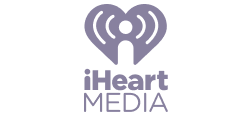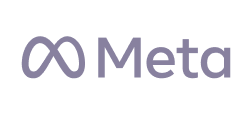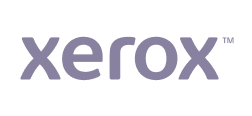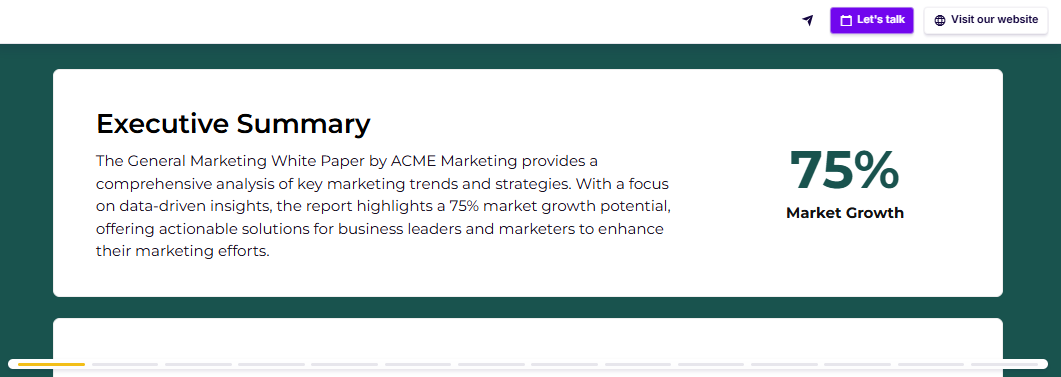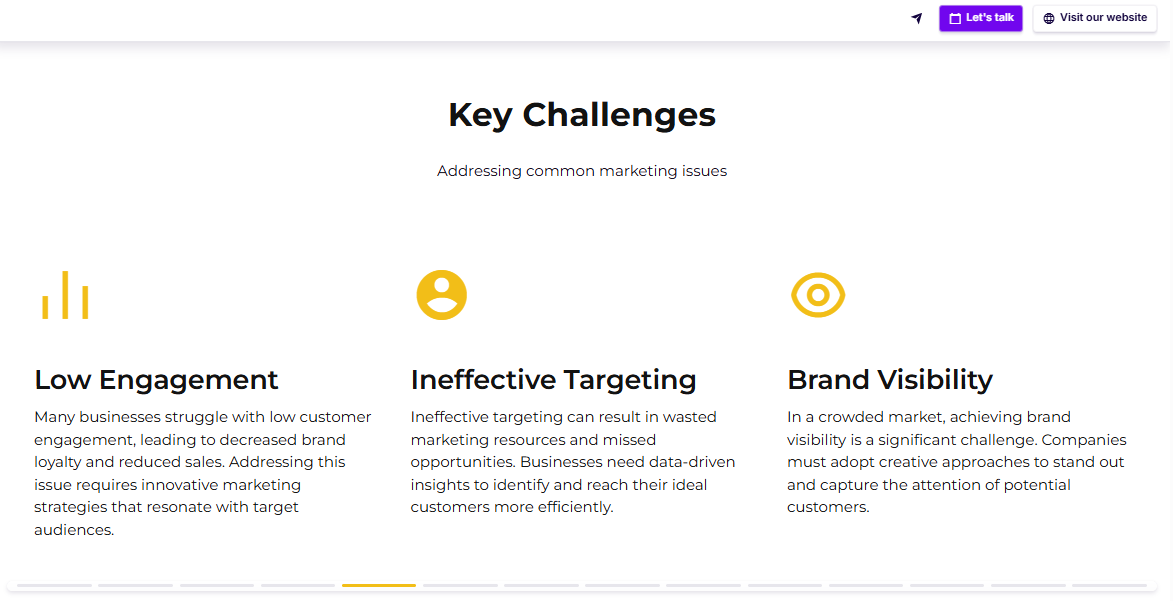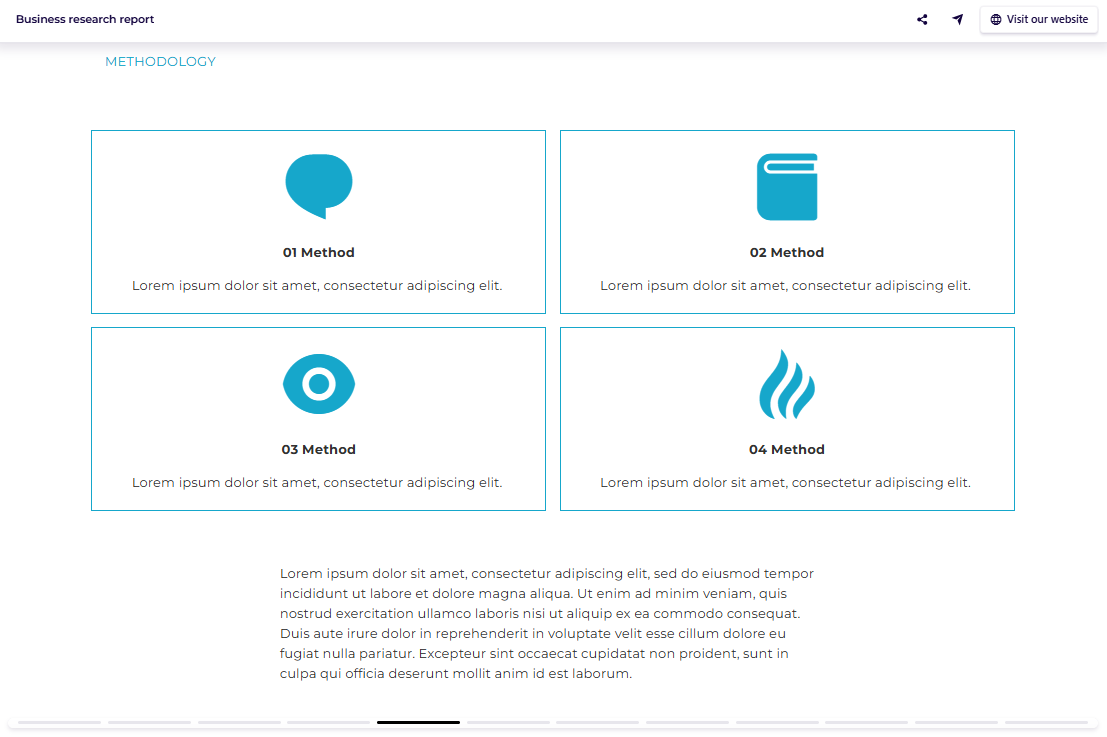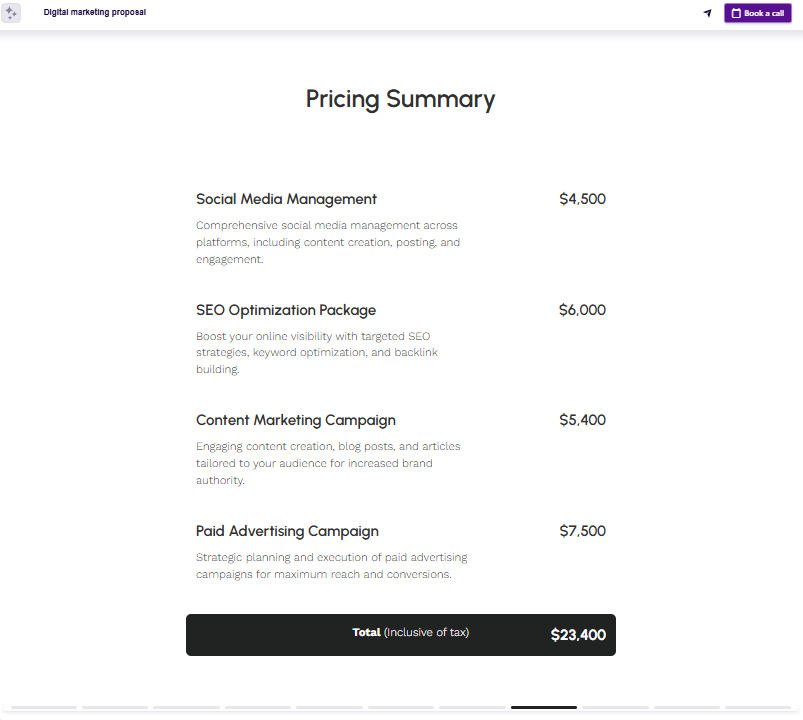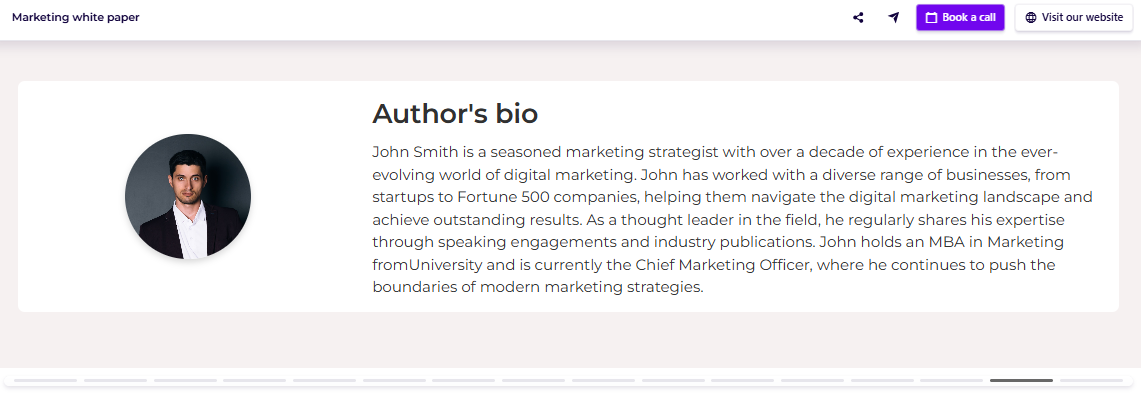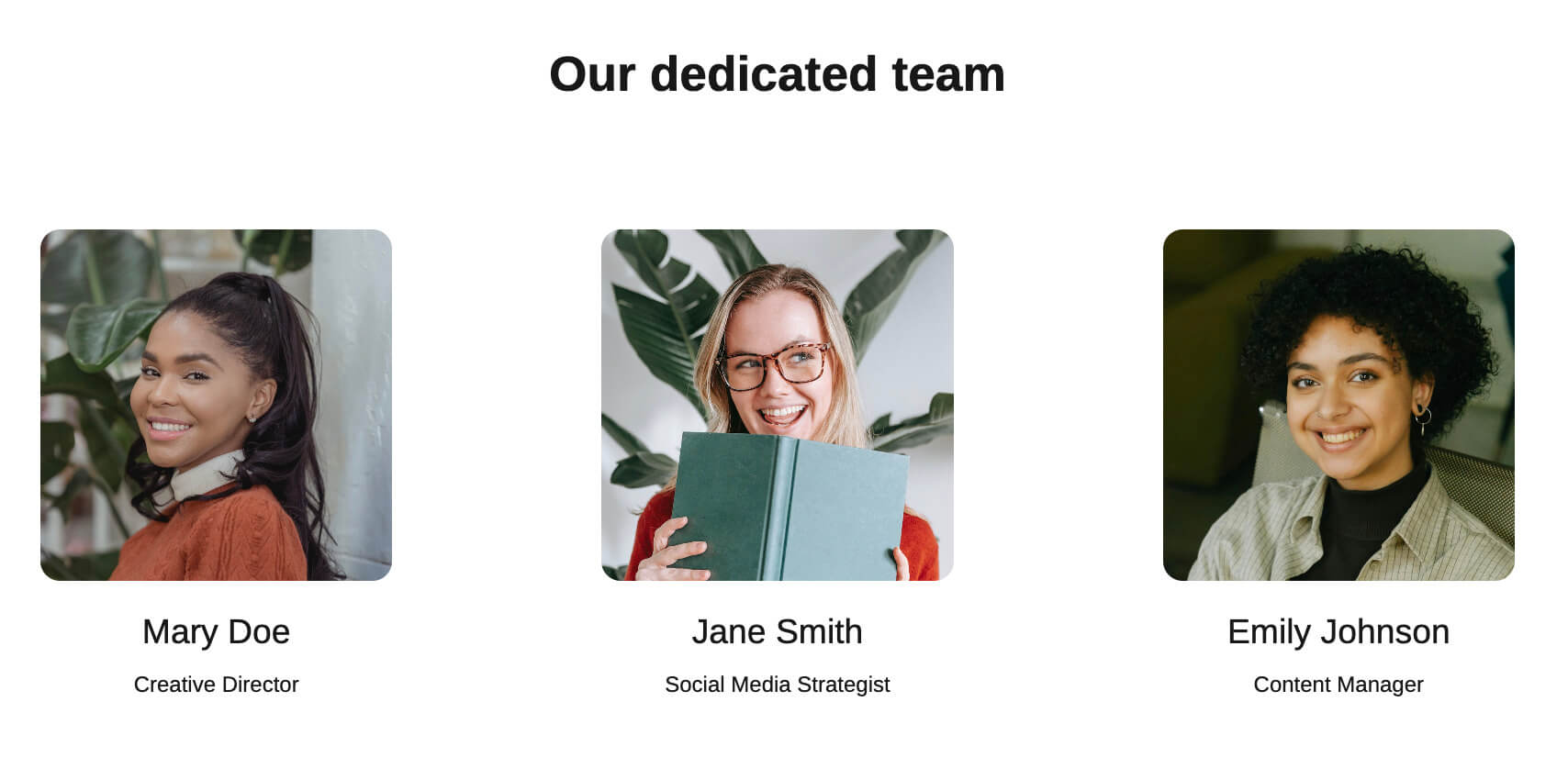How to Write a Marketing Research Proposal (+Templates)
Learn how to make a proposal for marketing research, including tips on the best marketing proposal format and a gallery of research proposal templates.


Learn how to make a proposal for marketing research, including tips on the best marketing proposal format and a gallery of research proposal templates.
Short answer
A marketing research proposal is a document that outlines a plan for conducting research to solve a marketing problem or answer questions about a market. This proposal describes what the research aims to accomplish and how it will be carried out.
A marketing research proposal is typically written before any research begins, as a way to secure approval, funding, or client agreement to proceed.
Is a marketing research proposal the same as a market research proposal?
A market research proposal focuses on understanding the external market - like customer behavior, trends, or competitor analysis.
A marketing research proposal is broader: it includes market research but also covers topics like pricing strategies, campaign performance, or brand perception.
Technically, a marketing research proposal has a wider scope, but in practice, both terms are often used interchangeably to describe documents that serve a similar purpose.
Who creates marketing research proposals?
A market research agency or consultant preparing a proposal for a potential client. In this case, the proposal is essentially a pitch to win business - it “sells” the research services by showing the client how the research will be done and how it will help them.
An in-house researcher or marketing team writing for internal stakeholders. In a corporate setting, a marketing manager or research analyst might create a research proposal for company leadership (e.g. the marketing director or executives) to get buy-in for a study, demonstrating how the planned research will provide valuable insights to guide the company’s marketing decisions.
An academic or student in the field of marketing. In universities, students or researchers make marketing research proposals to outline a planned study (for example, as part of a thesis, dissertation, or grant application). Here the audience might be a faculty advisor, review committee, or funding agency.
What is the goal of a marketing research proposal?
Bidding for projects: A market research firm responding to a marketing research Request for Proposal (RFP) from a company will write a detailed market research proposal to win the contract. It outlines exactly how they plan to address the client’s research questions (e.g. “What is the demand for electric cars among urban commuters?”) and demonstrates their approach and credibility.
Planning a new marketing initiative: Before a company invests in a major marketing initiative, they might do research to guide their strategy. For example, if a company considers entering a new market or launching a new product, they would need a market research proposal describing how they will research the opportunity (market size, customer preferences, competitor analysis, etc.) to inform the go/no-go decision. Likewise, if the company wants to test different marketing messages or ad campaigns, a marketing research proposal would outline how to conduct that research (such as focus groups or A/B testing of ads).
Academic research projects: A Ph.D. student in marketing might write a marketing research proposal to propose a study on, say, consumer behavior in e-commerce. The proposal would be required by the academic committee to ensure the student has a sound research plan before they proceed. Similarly, professors seeking funding often submit research proposals to grant agencies detailing what they intend to study in the marketing domain and how.
Internal decision support: If a business’s marketing department needs budget approval for market research, they will create a proposal for the higher-ups. For example, a marketing manager might draft a proposal to conduct customer satisfaction research, which will justify the cost by explaining how the insights could improve customer retention.
What to include on your title slide
A clear, specific title (e.g. Understanding Gen Z Attitudes Toward Electric Cars)
Name of the research team or agency
Client name or commissioning party
Date of submission
Version or proposal number (if applicable)
What to include in your executive summary
The core problem or research question
A one-line summary of the research methodology
What decisions this research will support
The benefit to the company (e.g. reduced churn, better targeting, smarter pricing)
If relevant, note whether your team will also support implementation of findings - such as adjusting campaign strategy, running tests, or optimizing touchpoints.
Don’t try to cram in every detail. Just enough to get a “yes, this is worth it” reaction. Save the rest for the deep-dive slides that follow.
Examples of problem statements
“Sales of Product X have plateaued in key regions despite increased ad spend.”
“We’ve seen a spike in Gen Z engagement but don’t fully understand what’s driving it.”
What to include in your background and problem statement section:
A summary of the marketing challenge or growth area you're aiming to explore
Relevant background (e.g. market trends, customer behavior, company performance)
Existing data, research, or findings that led to the proposal
A defined knowledge gap - what you still don’t know and need to find out
(Optional for academic or formal proposals) A short literature review or theoretical framing to show what’s already been studied and where your research will contribute something new
What to include in your research objectives section
A brief sentence outlining the overall aim of the research
2-4 specific, actionable objectives tied to the business context
A few key research questions or hypotheses the study will explore
A clear link to how the insights will be used (e.g. “to inform product development”)
Examples of research objectives
“Determine the top 3 factors customers consider when choosing Product X”
“Assess brand awareness and sentiment for Company Y among 18–24-year-olds in the UK”
“Identify which features would increase trial-to-subscription rates by at least 15%”
What to include in your research methodology section
Data sources - Will you gather new data (e.g. surveys, interviews), analyze existing data (reports, sales figures), or combine both?
Research instruments - What tools will you use (e.g. questionnaires, interview guides, discussion prompts)? Mention sample questions or key themes if helpful.
Sampling plan - Who are you targeting, how many, and how will they be selected? Be clear about segmentation, quotas, and recruitment channels.
Data collection methods - How will responses be gathered (e.g. online survey, in-depth interview, in-store observation), and why is this the right fit?
Analysis plan - A short explanation of how the data will be analyzed and translated into insights that support decision-making. Mention what type of results the client can expect (e.g. regression outputs, thematic summaries, dashboards, or reports).
Optional extension - If your team also supports strategy or execution, briefly flag how these insights might be applied (e.g. campaign adjustments, website optimization, messaging tweaks).
Example of a research methodology section
We propose a two-stage approach.
Phase 1: Two focus groups with Gen Z consumers to explore perceptions of our messaging.
Phase 2: An online survey with 500 respondents to test concepts and quantify preferences.
Data will be analyzed using thematic analysis for the qualitative phase and regression analysis for the quantitative phase. We’ll deliver a final report, interactive dashboard, and key strategic takeaways.
If desired, we can also support implementation - such as refining campaign assets, developing new targeting strategies, or running controlled experiments based on the findings.
What to include in your data collection section
Fieldwork timeline - Just mention when you’ll start collecting data and when it’ll end. Doesn’t need to be complicated - something like “mid-July to early August” works fine.
Sample size and quotas - Say how many people you want to hear from, and if you’re aiming for a mix (like different age groups or locations), explain how you’ll make sure that happens.
Recruitment method - Talk about where your participants will come from. That could be your customer list, a research panel, or just people you approach in public. If people need to meet certain criteria to take part, include that too.
Pilot test or soft launch - A small test run helps you spot problems early. It’s an easy way to make sure the questions make sense and everything works before you roll it out fully.
Data collection channels - This is just how you’ll actually gather the data. Maybe it’s through an online survey, phone interviews, or talking to people in-store. If the method affects how long it’ll take or how much it’ll cost, it’s good to mention that.
Quality control steps - Let them know how you’ll keep the data clean. That could mean removing duplicates, checking for weird answers, or reviewing a few interviews to make sure everything looks right.
Client visibility and updates - Some clients like to keep an eye on how things are going. You can give them access to a dashboard, send them quick updates, or just check in regularly.
What to include in your timeline section
Key project phases - Break the work into stages (e.g. setup, recruitment, data collection, analysis, reporting).
Estimated dates or durations - Add realistic timelines for each phase. Factor in holidays, response delays, and time for stakeholder reviews.
Dependencies and approvals - Note where certain tasks rely on others. Example: “Survey launch contingent on client sign-off by [Date].
Deliverable deadlines - Show when decision-makers can expect draft results, final reports, or presentations.
Time-sensitive milestones - Highlight deadlines linked to external events (e.g. a strategy meeting, product launch, board presentation).
What to include in your budget section
Itemized costs - Break costs down by task. You can include both the cost of conducting the research and, if relevant, the cost of implementing solutions based on the findings - such as campaign adjustments, testing, or optimization work.
Total cost - List the full amount. Clarify whether it includes tax, and note any optional add-ons.
Funding note (for academic/internal) - Say where the money will come from and how it’ll be used. Mention if co-funding or in-house support is needed.
What to include in your deliverables and reporting section
Final deliverables – Will you provide a written report, presentation slides, dashboards, raw data files, or a strategy workshop? Outline what stakeholders will actually receive.
Report structure – Describe how findings will be presented (e.g. executive summary, key insights with charts, recommendations, appendices with full data tables).
Special analyses or visual outputs – Mention any advanced techniques (e.g. segmentation, conjoint, personas) or visuals like infographics or interactive dashboards.
Interim deliverables – If you plan to share topline results, progress updates, or early reads during the project, include that here.
Delivery format – Specify how outputs will be shared - PDF reports, live dashboards, editable slides, or custom formats that suit your stakeholders’ needs.
Presentation / debrief – Will you run a results session, internal handover, or strategy debrief to walk through the findings and next steps? Add that here if it’s part of your offering.
What to include as an agency or consultant
A short company background and mission
Past work examples or relevant case studies
Client logos or testimonials (if space allows)
Team bios or key personnel who will lead the research
What to include for an internal project
Roles and responsibilities of the team involved
Relevant internal experience (e.g. past research, product knowledge, campaign involvement)
Cross-functional collaborators (e.g. marketing, product, CX)
Points of contact for each stage of the project
Any internal or external support (e.g. analytics team, external recruiters, platform vendors)
What to include in an academic proposal
Researcher credentials
Relevant publications
Institutional affiliation
Any required ethical approvals (especially for studies involving human subjects)
Examples of effective calls to action
Embed a live calendar so prospects or stakeholders can book a meeting instantly
Include a live chat or contact form to start the conversation on the spot
Add an e-signature option and T&C slide to fast-track approvals
Link directly to your social media or portfolio
Stop losing opportunities to ineffective presentations.
Your new amazing deck is one click away!

